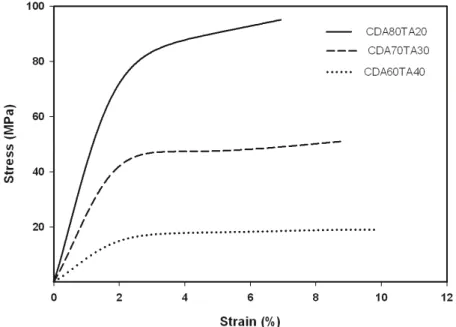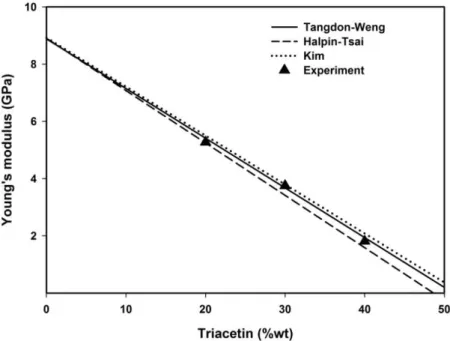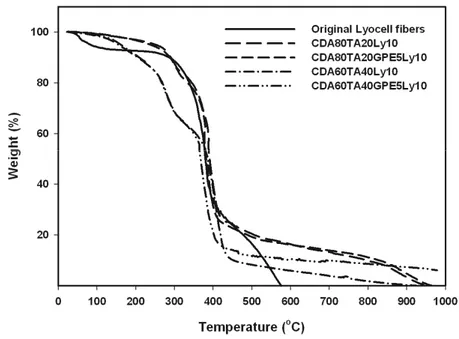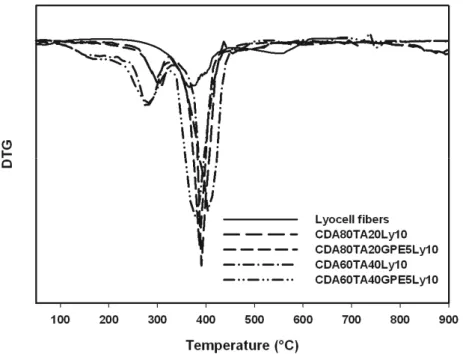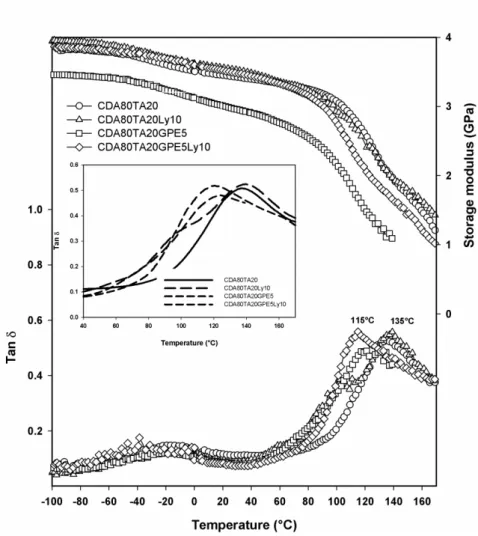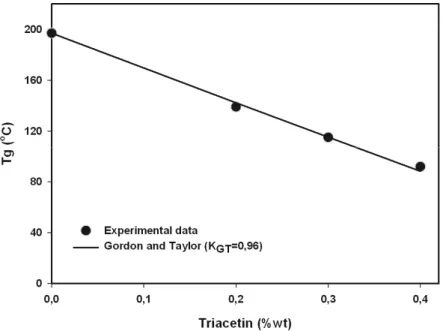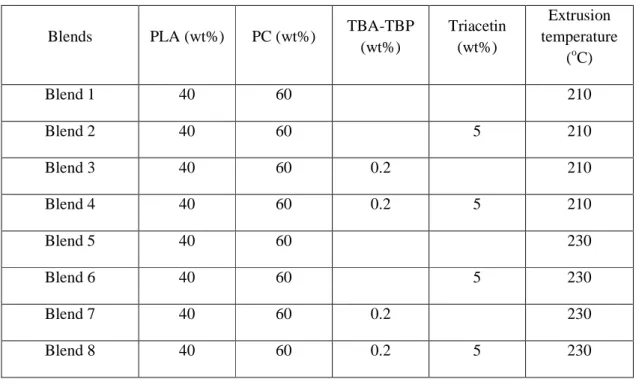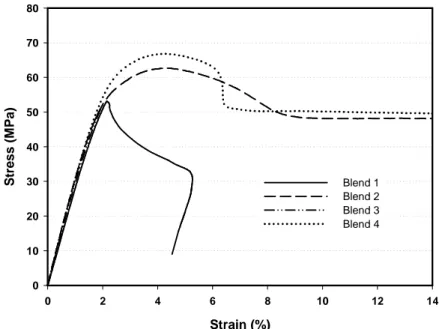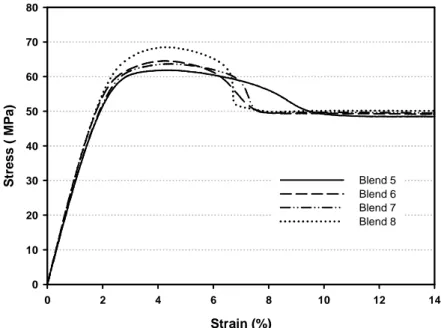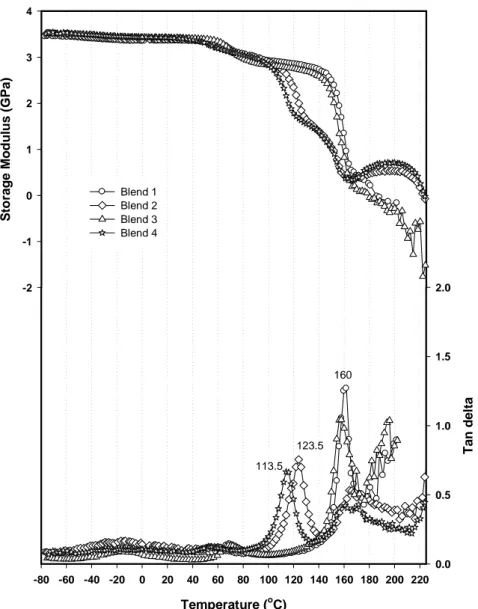UNIVERSITÀ DI PISA
E
NGINEERING
P
H
D
S
CHOOL
“L
EONARDO DA
V
INCI
”
PhD Thesis
SUSTAINABLE
BIOCOMPOSITES
FROM
RENEWABLE
RESOURCES
AND
RECYCLED
POLYMERS
V
UT
HANHP
HUONG
Supervisor:
Professor Andrea Lazzeri
PhD Course in
CHEMICAL ENGINEERING AND MATERIAL SCIENCE
(SSD ING-IND/22) XXIII cycle 2010 - 2012
Sustainable Biocomposites from Renewable Resources and Recycled Polymers
I
Contents
Chapter 1: Sustainable Biocomposites Review: Concepts, Current Applications and Research Tendencies 1
1. Plastics and sustainability: current issues and open problems 1 2. Plastics recycling 3
3. Concept of sustainable bio-based materials 4 3.1 Renewable resources 4
3.2 Bio-based 4
3.3 Biodegradable plastic 5 3.4 Compostable plastic 5
3.5 Main types of Bioplastics and Applications 5 3.6 Sustainable materials 7
4. Biocomposites 8
4.1 The current application of bicomposite and research tendency 9 4.2 Natural fibers/biofibers 11
4.3 Biopolymer matrix for composite 15 4.3.1 Cellulose Acetate 15 4.3.2 Polylactic acid 17 5. The aims and structure of thesis 20
5.1 The aims of thesis 20 6. References 22
Chapter 2: “Green” Biocomposites Based on Cellulose Diacetate and Regenerated Cellulose Microfibers: Effect of Plasticizer Content on Morphology and Mechanical Properties 34
1. Introduction 34 2. Experimental details 37 2.1 Materials 37 2.2 Processing 39 2.3 Characterization methods 40 3. Theoretical analysis 41 3.1 Constitutive equations 41
Sustainable Biocomposites from Renewable Resources and Recycled Polymers
II 3.2 Young's modulus 42
3.3 Yield stress 44 4. Results and discussion 45
4.1 Mechanical properties of CDA-based blends and composites 45 4.2 Thermal behaviour 55
4.3 Relaxation transitions, structure 60 4.4 Morphology 64
5. General discussion 67 6. Conclusion 69 7. References 70
Chapter 3: Compatibilization of Poly(lactic acid)/Polycarbonate blends through reactive blending and in-situ copolymer formation 76
1. Introduction 76 2. Experimental details 80 2.1 Materials 80 2.2 Processing 81 2.3 Characterization methods 82 3. Theoretical analysis 84
4. Results and discussions 86
4.1 The effect of processing conditions 86 4.1.1 Mechanical properties 87
4.1.2 DMTA (Dynamic mechanical thermal analysis) 90 4.1.3 Thermogravimetric Analysis (TGA) 94
4.2 Investigation of all compositions 99
4.2.1 Mechanical properties of all blends 101 4.2.2 Thermal behaviour 103 4.2.3 Structure analysis 112 4.2.4 Morphology 117 4.2.5 Biodegradation 120 5. Conclusions 124 6. References 126
Chapter 4: Biocomposites Based on Poly(lactic acid)-graft-Polycarbonate bisphenol A Copolymers and Regenerated Cellulose Microfibers 130
Sustainable Biocomposites from Renewable Resources and Recycled Polymers III 1. Introductions 130 2. Experimental details 133 2.1 Materials 133 2.2 Processing 134 2.3 Characterization methods 134 3. Theoretical analysis 135 3.1 Young's modulus 136 3.2 Yield stress 137 4. Results and discussions 138
4.1 Mechanical properties 138 4.2 Thermal behaviour 146 4.3 Relaxation and structure 150 4.4 Morphology 153
5. Conclusions 154 6. References 156
Chapter 5: Analysis on the influence of interface interactions on the mechanical properties of nanofiller and short fiber- reinforced polymer composites 161
1. Introduction 161 2. Theoretical analysis 163 3. Discussion 171
4. Conclusions 179 5. References 181
Chapter 6: General Conclusions 185 Chapter 7: Scientific Productions 191
i
Abstract
Chapter 1. General introduction
Chapter One reports on a review of sustainable biocomposite materials. The concepts on sustainable materials, renewable resources, biopolymers, biocomposites, are summarized from the literatures as background theories for this thesis. The situation of plastic materials and its effects on the environment, health, disposal matter (landfills, incinerations, mechanical and biorecycling) are defined to explain why the applications of biopolymers and biocomposites are necessary for research and industry. Current applications and the market of biopolymers, biofibers, and biocomposite materials are reported and analyzed. The availability of current biofibers or natural fibers on the market are listed and compared with mechanical properties and their economic value as oppose to non-biodegradable materials such as glass, carbon fibers, etc. Moreover, biopolymer and bio-based materials are being developed not only on quantity, but also for the quality of materials. In addition to this, their prices are getting cheaper. Therefore, biocomposites will become potential materials for diversified applications in the future. The investigation into current research and applications of biopolymer and biocomposites are essential to find new research directions for this thesis and its application to develop new materials that have high mechanical and thermo resistance and biodegradability. Specially, some new tendencies and new challenges found in the development of biopolymer-like celluluse diacetate, polylactic acid, starch and biocomposites are discussed. Consequently, not only the research presented in this thesis has been focused on industrial application, but also on the solution of some critical environmental problem.
Chapter 2. “Green” biocomposites based on cellulose diacetate and regenerated cellulose
microfibers: Effect of plasticizer content on morphology and mechanical properties
In Chapter Two, The mechanical properties of biocomposites based on CDA considered in the literature are still not satisfactory in view of their possible applications, and the use types of processing are not economically viable on an industrial scale. In particular, the thermal characteristics of the materials developed and their matrix-filler interactions were not much investigated. So far, there are no
ii publications about the effects of multi plasticizers on physical properties, thermal stability and morphology of cellulose diacetate/cellulose fibers composites under melt processing. Since both the cellulose diacetate and Lyocell fibers can be produced from renewable forest biomass, their manufacturing does not imply any competition for land and water required for food production. From that reasons, a new processing method was developed for cellulose diacetate (CDA) based biocomposites by melt processing. The new strategy developed in this work makes use of two different plasticizers: a primary “external-type” or “non-reactive-type” plasticizer, Triacetin (TA), added prior to extrusion to enhance the “processing window” of the polymer and a secondary “internal-type” or “reactive-type”, Glycerin Polyglycidyl Ether (GPE), added during the extrusion step to reduce the amount of potential volatiles or leachable products in the final product and to help in the reduction of viscosity and thus further improving processability. The thermo-mechanical properties and the morphology of biocomposites with Lyocell microfibers, other wood based fillers, which are typically considered as a reference to produce “green” biocomposites from natural resources, have been analyzed.
Chapter 3. Compatibilization of Poly(lactic acid)/ Polycarbonate blends through reactive blending
and in-situ copolymer formation.
To diversify the biopolymers from different resources and combine them with recyclable polymers from oil, we developed new biodegradable copolymers based on Polylactic acid and aromatic polycarbonates through a process of reactive blending in the molten state by the presence of a multi-catalyst. Maintaining the mechanical properties of materials at high temperatures are preferably suitable for the production of materials for different industrial sectors such as transportation, electronics and the electrical equipment industry. Polylactic acid is currently the most used biopolymer, but the materials produced with it are brittle and have low thermo resistance. To extend the functional ability of PLA to different applications such as electric components, food trays, car components, etc. The melting blends of Polylactic acid (PLA) and Polycarbonate bisphenol A (PC) prepared in different temperatures are investigated for the mechanical properties, thermo resistance and morphology. The blends show phase separation; the adhesion between two phases of polymers are poor due to high surface tension of each
iii components. The multi-catalyst (tetrabutylammonium tetraphenylborate-TBATBP and Tricaetin-TA) is added to increase the interaction between the two phases in order to enhance the mechanical properties and thermo resistance of materials. The dynamic mechanical thermal analysis test shows a new peak in tan δ that does not occur in the blends with a catalyst. This new peak appears at a temperature Tgp lower
than the Tg of PC and higher than the Tg of PLA. This aspect is related to the presence of PC-blocks in the
copolymer. The tensile, thermogravimetric Analysis (TGA), differential scanning calorimetry (DSC), scanning electron microscopy (SEM), transmission electron microscope (TEM) and aerobic biodegradability tests confirmed that the copolymer was formulated under the action of catalysts. However, the Size Exclusion Chromatography (SEC), Nuclear magnetic resonance (NMR) and Fourier Transform Infrared Spectroscopy (FITR) do not show direct evidence of a change in the materials’ structure due to similar polar function groups of PLA and PC. The new copolymer has been investigated regarding its mechanical properties, morphology, thermal properties and biodegradation behavior to satisfy the understanding of all the properties of these potential materials, which will serve for broadening the application of bio- and biobase-polymers on the market. Moreover, it will be used as a matrix for biocomposites with required high mechanical properties and thermo resistance.
Chapter 4. Biocomposites based on Poly(lactic acid)-graft-Polycarbonate bisphenol A copolymers
and regenerated cellulose microfibers.
After the development of a copolymer matrix with high mechanical properties and thermal resistance, in this chapter we move back to our main focus to develop bio-base composite materials. The blended Polylactic acid (PLA)/ polycarbonate bisphenol A (PC) copolymer and Lyocell fibers with different fiber contents and investigated the composites in terms of their mechanical properties, thermo resistance and relaxation structure, which are shown in Chapter Four. On the physical mixing, the adhesion between two phases of polymers and the interaction between the fibers and matrix are poor. Therefore, not only do the Lyocell fibers reduce the thermo resistance of composites, but they also decrease the elongation at break of materials. However, the presence of multi-catalysts not only formulates a new copolymer, but also increases the interaction between the fibers and polymer matrix,
iv therefore counterbalancing the negative properties of the PLA/PC/Ly composites. The in-situ-transesterification reaction of the polymer during melt-blending which enables to obtain the reaction between the ester group of the polylacti acid and the hydroxyl function of cellulose fibers. Exploiting catalysts for formulating copolymers to increase the interaction between fibers and the matrix can open new methods for producing biocomposites.
Chapter 5. Analysis on the influence of interface interactions on the mechanical properties of
nanofiller- and short fiber- reinforced polymer composites
Chapter Five developed a new method to estimate the interface shear strength of the fiber and polymer matrix. The Pukánszky's model for tensile strength, originally developed for filled composites, has been recently used with success for short fiber-reinforced composites and various nanocomposites, although no theoretical justification has been provided so far for this new use. Despite its simplicity and widespread use to characterize nanoparticle- and short fiber-reinforced composites, the adimensional Pukánszky interaction parameter B-factor is not related to physical-mechanical parameters such as the interfacial shear strength, τ, and other experimental variables such as the filler aspect ratio (ar) and
orientation factor.
In this thesis Pukanszky’s equation has been analyzed in terms of the Kelly-Tyson model for the prediction of composite strength. In this way it was possible to establish a direct link between Pukanszky’s interaction parameter B and fundamental material parameters such as tensile strengths of the matrix and of the fibers, the aspect ratio of the fibers, and the orientation factor and the interfacial shear strength IFSS. It was also possible to determine the minimum value of B for which it is possible to predict the tensile strength of the composite from the modified rule of mixtures, as well the maximum value that B can achieve in the case of continuous aligned fibers with the same type of matrix, fibers and interface shear strength. Moreover, a critical volume fraction, φcrit, was defined corresponding to the minimum
amount of filler content necessary for the composite strength to be greater than the strength of the unreinforced matrix, i.e. corresponding to the case σc=σm. It was also shown that for this condition Bcrit≅3.
v From this analysis it was possible to express the interfacial shear strength in terms of B and other material parameters, Eq. (13). From such equation, it is possible to verify the monotonical relation between B and IFSS that has been suggested previously in the literature.
A few examples of calculations of the IFSS, τ , from Pukánszky’s interaction factor B have been provided, using published literature values relating to nanocomposites with organically modified nanoclays and carbon nanotubes, as well as composites reinforced with short natural fibers. All results obtained fall within the value expected from similar literature values and below the maximum predicted according to the von Mises criterion, = /√3.
The new equations presented in this work provide a theoretical basis for the use of Pukánszky’s model in the case of nanocomposites and discontinuous fiber composites. Compared to the traditional Kelly-Tyson approach, the interaction factor B enables to give a rapid estimate of the interface shear strength even when fundamental material constants such as fiber tensile strength, aspect ratio and orientation factor as well as the stress in the matrix when the composites breaks, cannot be simply evaluated. This new approach can therefore be appreciated in research and in the development of new composites in industrial environments.
Chapter 6. General conclusions
In the final chapter the results of the thesis will be compared with original aims of this research and the new materials developed will be evaluated. The advantages and disadvantages of each biopolymer and biocomposite produced will be summarized, based on their mechanical properties, thermal resistance, and morphology. From this viewpoint, some of the materials will be developed on an industrial scale for the production of "green composites" with a pilot extrusion machine. The results of this thesis could not only be applied to Italian plastic companies but to the whole European bioplastic industry,and in general to all enterprises active in the most advanced countries of the world .
Sustainable Biocomposites from Renewable Resources and Recycled Polymers
1
Chapter 1: General Introduction
I. PLASTICS AND SUSTAINABILITY: CURRENT ISSUES AND OPEN PROBLEMS
Today, plastic materials are widely used due to their diversity in terms of type, properties, and their applications in our daily lives. In fact, plastic materials are the first choice for the production of almost all components because they are durable, light, safe, chemical and water resistant, easy to process and are cost effective. Regarding industry, plastic materials can be applied in packaging (37%), construction (20.6%), automobile manufacturing (7.5%), electronic devices (5.6%), as well as in other applications (27.3%). This wide range of application has lead to a sudden increase in their development in recent years, not only in technology advancement, but also in the sheer quantity of production. According to the European plastic market organization report, the amount of plastics production has increased more than five hundred percent from 1976 to 2010 [1].
Despite these positive aspects, more than 90% of plastic or polymer materials available in the market are produced from oil. As the use of plastics increases, the number of oil fields necessary to meet this demand is insufficient. Moreover, the polymer is durable and has a high molecule weight, leading to a long lifetime on land and sea for hundreds of years. In addition, the production and degradation process of plastic can produce large quantities of carbon dioxide and toxic gas, adding to the greenhouse effect and therefore contributing to worldwide climate change [2-3].
To summarize the positive and negative effects that plastics have on the environment, the European Union has released some framework conditions for plastics expressed in Europe [1,4].
Sustainable Biocomposites from Renewable Resources and Recycled Polymers
2
Policy Framework Legal framework
* General Polices
- Sustainable Resource Strategy:
+ Promotion of energy efficient production
+ Resource use: promote recovery + and recycling (landfill no future option), drive use of Recycling and Resource Management (RRM - “low carbon economy”)
- EU Integrated Product Policy:
+ Conception of products with the highest possible degree of sustainability – from the cradle to the grave
- Sustainable Industrial product policy
(SIP)
* Specific Initiatives on European Level
- Green paper on market-based instruments for environmental technologies
+ Discusses / proposes measures like labeling, eco-taxes, CO2 -trading, VAT, standardization, PR campaigns
- Sustainable Industrial Policy on
bio-based products
+Lead Markets Initiative for bio-based products
+EU Policy Leaders Browne and Sarkozy proposal of VAT Reduction (5% in EU)
* European Packaging
* Packaging Waste Directive - Allow composting of packaging * Germany
- Germany Packaging Ordinance: Regulation of compostable plastic packaging
- Certificate biopackaging will be exempted from recycling obligation until 2012. Value is € 0.5-0.8 for bioplastic.
- Exemption planned of deposit for beverage bottles with > 75% RRM until 2012. Supported by Coca Cola.
* France: Law on Agriculture includes mandatory use of disposable retail carry bags, cotton buds and waste bags by 2012 (challenged by European Commission - therefore pending)
* Italy: Intended mandatory bio-degradable bags from 2009 pending (Challenged by EC) *UK/ Austria/ Cities: Looking for specific recycling solutions and look for biodegradable packaging.
* Netherlands: Subsidies from Ministry of Environment for bringing down cost of compostable packaging; taxation of fossil-based polymers
* Belgium: Compostable bags exempted from packaging tax pending. Value of € 0.3/kg
Sustainable Biocomposites from Renewable Resources and Recycled Polymers
3 In the analysis of the policy and legal framework for plastic production and its applications, two main tendencies emerge that regard both the plastics industry and the plastics market.
- Recycling plastic materials
- Using renewable resources or sustainable materials to produce bioplastics, which are
biodegradable, bio-based, compostable, and fast arriving in new applications
II. PLASTIC RECYCLING
Manufacturing plastics requires large quantities of energy, labor, natural resources, water and harmful chemicals, which can strongly effect the environment and human health. They are also are durable and persist for long periods of time, therefore greatly affecting the environment. The Association of Plastic Manufactures in Europe has concluded that 1.8 tons of oil are saved for every ton of recycled polyethylene produced [5]. Recycling plastic also reduces energy consumption, reduces the amount of solid waste going to the landfill and helps reduce the greenhouse effect, along with saving precious natural resources.
Sustainable Biocomposites from Renewable Resources and Recycled Polymers
4 Despite the positive effects of recycling plastics, many applications do not utilize pristine polymers such as trays, pots, toys, electric components, and house construction components, impacting the development of the plastic recycling industry and market. Several polymers can be recycled such as low density polyethylene (LDPE), high-density polyethylene (HDPE) , polypropylene (PP), PVC (Polyvinyl chloride), , polystyrene (PS) and polyethylene terephthalate (PET) , from bottles, trays, film, tubes, shopping bags, as well as polycarbonate of bisphenol A (PC), and acrylonitrile butadiene styrene copolymer (ABS) from electric components, cups, and toys [6-7].
III. CONCEPT OF SUSTAINABLE BIO-BASED MATERIALS
3.1 Renewable resources.
Until now, this concept has not been defined officially in scientific terms. The definition of “renewable resources” according to Wikipedia is a “natural resource (such as wood or solar energy) that
can be replenished naturally with the passage of time, either through biological reproduction or other
naturally recurring processes” [8].
In terms of plastic materials, only those polymers that are produced from renewable resources, natural renewable energy, agriculture resources such as cellulose, corn, starch, natural sugar, or those resources that can be re-produced from nature can be called a biopolymer or a bioplastic. Conversely, almost all plastics are produced from petroleum. Following the definition of the European Bioplastic Organization, bioplastics can be bio-based, biodegradable or both [9].
3.2 Bio-based materials
The American Society for Testing and Materials (ASTM) defined a bio-based material as “an
organic material in which carbon is derived from a renewable resource. A commodity or resource that is
inexhaustible or replaceable by new growth) via biological process (ASTM D6866) [10]”. The product
Sustainable Biocomposites from Renewable Resources and Recycled Polymers
5 As of now, bioplastics do not have many advantageous properties, as compared to the polymers from oil, because it is a new field in research and development. However, they present several benefits that are environmentally friendly, for example:
+ They need less time to break down after being discarded, so that means there will no longer be tons of plastic dominating our landfills;
+They are produced from renewable resources, so the bioplastics will be easy to renew or recycle because they were produced from biomass, or also animal fats, meats or other tissues;
+ They are good for the environment because there is no harm done to the earth when recovering fossil fuels. Also, in this process there are very few greenhouse gasses and harmful carbon emissions, thereby decreasing the greenhouse effect. Moreover, bioplastic production needs less energy and few harmful chemicals [11-16].
3.3 Biodegradable plastics
Similar to bio-based plastics, a biodegradable plastic was defined by the American Society for Testing and Materials as “a degradable plastic in which the degradation results from the action of
naturally occurring microorganisms such as bacteria, fungi, and algae. Biodegradable plastics must
biodegrade in specific environments such as soil, compost, or marine environments (ASTM D6866)” [10].
Biodegradable plastics can be made from oil or natural resources; it is not important where the materials come from, they need only to meet the requirements defined above.
3.4 Compostable plastics
“ A plastic that degrades by biological processes during composting to yield CO2, water, inorganic
compounds and biomass at a rate consistent with other known compostable materials and leaves no
visible, distinguishable or toxic residues. Toxic residues important for compost quality include heavy
metal content and serotoxins (ASTM D6400) [17]”
Sustainable Biocomposites from Renewable Resources and Recycled Polymers
6
Biodegradable/ compostable Name Application
Synthetic Polyesters (BASF, Mitsubishi, etc.)
polybutyleneadipate/ terephthalate (PBAT), polysuccinate (PSN),
polybutylene succinate adipate (PBSA),
Films, toughening agents for brittle biopolymers, bottles, etc.
Biodegradable/ compostable
and Bio-based Name Application
NatureWorks, Purac/ Synbra,
Futerro, Sidaplax, etc Polylactic acid (PLLA, PDLA) Rigid containers, film, barrier coating, cosmetic covers, etc. Novamont, Sphere-Biotec,
Plastic, etc Starch based materials
Loose fill, bags, films, trays, wrap films, etc
Innovia, Acetati, etc
Cellulose based materials, Cellulose diacetate (CDA), etc
Glass components, helmets, car components, food trays, etc
BASF, FKUR, etc PLA compounds/blends Films, tomato clips, tree-pots,
etc. Metabolix,, KaneKa, Biomer,
etc,
Polyhydroxyalkanoate (PHA), polyhydroxybutyrate (PHB), polyhydroxyhexanoate (PHH)
Films, barrier coatings, medicines, trays, etc.
Bio-based Name Application
Dupont
Bio-PDO based polymers, 1,3 propanediol (PDO), DuPont Sorona, DuPont Cerenol
Textile Fibers, Automotive Refinishing, etc.
Braskem, DOW PE, PP from Bioethanol
Cups, food trays, films, medicines, food packaging, beverage bottles, etc.
Solvin PVC from Bioethanol Pipes, etc.
Arkema, BASF, etc. Polyamides PA 6.6.9/6.10 Car components, bumpers,
electric components, etc.
Sustainable Biocomposites from Renewable Resources and Recycled Polymers
7 3.6 Sustainable materials
Similar to the concept of renewable resources, a consensus definition for sustainable materials does not yet exist. According to Mohanty et al. [22], a sustainable, based product is defined as “a
bio-based product derived from renewable resources having recycling capability and triggered biodegrability
with commercial viability and environmental acceptability”.
Furthermore, in terms of polymers, the Institute for Local Self-Reliance and European Plastic Organization [5-23] established that “a sustainable polymer is a plastic material that addresses the needs
of consumers without damaging environment, health, and economy. Feedstock for the production of
sustainable plastics must be renewable, such as plants, with preference to the use of by products or over
production. Synthesis, production and processing of sustainable polymers should use less net water and
renewable energy, emit less greenhouse gases and have a smaller carbon-footprint than their
non-sustainable counterparts, while still being economically viable.”
Figure 2. Concept of "sustainable" bio-based product by Mohanty et al. [22].
According to the definitions above, biopolymers or polymers produced from renewable resources can be considered sustainable materials. Biocomposites or composites made completely or partially from bio-resources (only the matrix or fiber) are also regarded as sustainable materials. In the expression of this concept, we can ascertain that sustainable materials could be biodegradable, whether they are recycled or
Renewable Recyclable Triggered
Biodegradable
Environmental Acceptability &
Commercial Viability
Sustainable Biocomposites from Renewable Resources and Recycled Polymers
8 not; but they must be produced from renewable materials. Regarding to development of friendly environmental materials, biocomposites are considered the most important candidates for the development of sustainable materials because they have high mechanical properties, are thermo resistant, and are cost effective, especially those based on biopolymer matrices and renewable fibers and fillers.
Considering those problems regarding the environment and the tendency of material development, sustainable materials have emerged as the materials of the future. For this reason, in 2009 the Sustainable Biomaterials Collaborative Network elaborated new principles for the development of sustainable biomaterials such as: the elimination of single-use products that can neither be recycled nor composted; avoiding fossil fuel-based materials; developing materials and products derived from renewable feedstock; growing feedstock as a resource for manufacturing biomaterials; and investigating the effect of sustainable materials on the environment, health, and social and economic justice [24].
IV. BIOCOMPOSITES
Composite materials have been around for many years. Over the past 30 years, the composite technology markets have developed greatly, especially on glass, carbon, aramid fibers, laminate, and thermoset. However, the composites based on long glass fibers or laminates and thermoset are still limited in their application in smaller and cheaper applications such as such as pots, trays, boxes, fishing cases, tubes, other car parts, chairs, etc. because they have a low elongation at break, are flexible and their processing is too expensive. Therefore, a choice was made to base composite materials on a thermoplastic matrix and short fibers and fillers. At the same time, processing methods, such as single/twin screw extrusion and injection, were updated in order to adapt to economic requirements.
Based on the development of composite materials and the appearance of new bio-based materials as well as the problems of plastic materials with the environment, a new brand of composite materials was formulated and called biocomposites to include totally or partially bio-based materials. This means that they can have a matrix, fiber or both, which are produced from renewable resources. Materials can be
Sustainable Biocomposites from Renewable Resources and Recycled Polymers
9 completely or partially biodegradable such as polypropylene/wood fibers, polylactic acid/glass fibers, polyamide/cellulose fibers, and polycarbonate/lignin.
4.1 Current applications of biocomposites and recent research tendencies
Nowadays, predictions about “peak oil” and the limits of oil production together with the consideration that the risk of environmental damage when drilling flor oil and gas and the extraction costs are increasing higher as these resources become less accessible, make biocomposites that present a wide range of advantageous properties especially important in engineering applications . Biocomposites are therefore receiving much consideration from many research groups, and industrial companies all over the world, more specifically in the automotive industry due to their low environmental impact and their cost effectiveness. Biocomposites can present the same performance for lower weights and, at the same weight as other composites, present 25-30% higher mechanical properties [22]. Depending on different components of the car, the fiber and matrix are selected to adapt with the using requirement of each components. Since petroleum plastics are still cheaper and easier to process than biopolymers, car components are being produced from polypropylene and biofibers such as flax, hemp, and kenaf. The goal is to decrease the lifetime of the material or it will be consumed naturally by bacteria, so the environmental impact of product will be reduced.
Biocomposites are not only promising materials for the automotive industry, but also for agriculture, the packaging field, construction and house components [25]. In agriculture, pots or tomato clips together with other articles are produced from biocomposites. Most of them are produced from polylactic acid, PHB or starch and wood fibers [22, 26, 27]. Their lifetime is short and can become fertilizer once used. This tendency will increase the life cycle of materials in nature as well as decrease the environmental impact. Moreover, biocomposites are the best candidates for choosing materials in packaging applications due to different requirements of the mechanical properties, size, and diversification in uses such as food packaging, containers for cosmetics, chemicals, fish transport, and biological eggs. All of them have a short lifetime and are 100% biodegradable.
Sustainable Biocomposites from Renewable Resources and Recycled Polymers
10 From the potential applications above, the development of biocomposites are following four tendencies [22, 27-30]:
• Develop new processing techniques to obtain new types or treatment biofibers using physical or chemical methods to obtain inexpensive yet high mechanical properties, cellulose content, uniformity, and high surface energy;
• Modification of the polymer matrix through functionalization, blending to increase the mechanical properties, thermo, oxygen, and chemical resistance, etc;
• Using a coupling agent or catalyst to modify the polymer matrix and/or increase the interaction of polymer and biofibers;
• Develop or select the best conditions for processing materials.
Due to the many different types of polymers and biopolymers, researchers have focused their attention on modifying the polymer matrix and the interaction with fibers, since it is rather easy to combine or enhance positive properties through the combination of different polymers. However, natural fibers such as kenap, helm, flax, tencel, coir, and coconut are not abundant [28,29]. The main goal of industry and research is to develop a processing technology in order to obtain a fiber that presents high physical properties, surface tension, cellulose content, and geometry. Moreover, fiber manufacturers are pushing to decrease the cost of processing together with diversifying the types of fibers in order to adapt the prices to the composite materials. The applications dictate the technical processes used for the composites. For example, traditional processing methods such as RTM, sheet molding, and resin transfer molding are used for long biofibers and thermoset. For short fibers and thermo plastics, extrusion and injection are fashionable, but it is not easy to find the best processing conditions for each material. Indeed modeling and research regarding processing is still an open field [27]. Typically the choice of processing method is adjusted according to the fundamental theory on rheology of the polymer and the experience of operator. In this thesis, we selected extrusion and injection for our processing method because it is easy to develop for industry and inexpensive to produce.
Sustainable Biocomposites from Renewable Resources and Recycled Polymers
11 Figure 3. Classification of biocomposites according to Mohanty et al. [22].
4.2 Natural fibers/biofibers
Biofibers have become increasingly popular in recent years because it has high mechanical properties when compared to glass or carbon fibers, is inexpensive, has a low density, is renewable and environmentally friendly being completely biodegradable. Along with the development of biocomposites, biofibers will become fashionable materials for the future, and this development will bring about a new revolution in materials technology [22-30].
There are different biofibers on the market made from biomass or renewable resources. Faruk et al. [27] has classified them into six categories: "bast fibers (jute, flax, hemp, ramie and kenaf), leaf fibers (abaca, sisal and pineapple), seed fibers (coir, cotton and kapok), core fibers (kenaf, hemp and jute), grass and reed fibers (wheat, corn and rice)," and finally wood flour, and regenerated cellulose fibers. In particular, the bamboo and coir fibers are undergoing development in recent years not only in quantity, but also in quality [31,32]. However, they are still coarse materials and have not made much progress for production as other commercial fibers have.
Natural/Biofiber Composites (Bio-composites)
Biodegradable Triggered Biodegradable Biofiber-Renewable Biopolymer Based (Polylactic acid/ Cellulose plastic/ Starch/ PHA, PHB) Biofiber-Petroleum Based Biodegradable Polymer (Biofibers-aliphatic Copolyester/ Polyesteramides) HYBRID BIO-COMPOSITES Two or more Biofibers Reinforced Biopolymer
Composite: Purpose To
Manipulate Bio-composite Properties & To Maintain Balance Among Ecology-Economy-Technology
Sustainable Biocomposites from Renewable Resources and Recycled Polymers 12 Lignocellulosic Fiber Density (g/cm3) Tensile Strength (MPa) Young’s Modulus (GPa) Bagasse (Saccharum officinarum) 0.34 - 0.49 135 - 222 15 - 17 Bamboo (Bambusa vulgaris) 1.03 - 1.21 106 - 204
Banana (Musa sapientum) 0.67- 1.50 700 - 800 27 - 32
Buriti (Mauritia flexuosa) 0.63 - 1.12 129 - 254
Coir (Cocos nucifera) 1.15 - 1.52 95 - 220 4 - 6
Cotton (Gossypium M.) 1.51- 1.60 287 - 800 6 - 13
Curaua (Ananas erectifolium) 0.57 - 0.92 117 - 3000 27 - 80 Flax (Linum usitatissimum) 1.30 - 1.50 344 - 1035 26 - 28
Hemp (Cannabis sativa) 1.07 389 - 690 35
Jute (Corchorus capsularis) 1.30 - 1.45 393 - 800 13 - 27 Piassava (Attalea funifera) 1.10 - 1.45 109 - 1750 5 - 6 Pineapple (Ananas comoscus) 1.44 - 1.56 362 - 1627 35 - 83
Ramie (Boehmeria nivea) 1.5 400 - 1620 61 - 128
Sisal (Agave sisalana) 1.26 - 1.50 287 - 913 9 - 28
Soft wood (spruce) 0.46 - 1.50 112 - 1000 11 - 40
Hard wood (birch) 0.67 - 1.50 300 - 1500 30 - 80
E-glass 2.50 - 2.58 2000 - 3450 70 - 73
Carbon 1.78 - 1.81 2500 - 6350 230 - 400
Aramid 1.44 3000 - 4100 63 - 131
Table 2. Density and Mechanical Properties of Selected LCFs [28-35].
The main problem of biofibers is that they are not uniform and that they contain a lot of natural chemical compounds such as lignin, wax, fat, hemicellulose, and water. They can reduce the physical properties of fibers as well as the interaction between fibers and matrix. The weak interface between the fiber and polymer matrix will affect the stress transfer from the matrix to the fibers, so it will reduce the mechanical properties of the final materials. Moreover, the natural compounds are also affected by the processing condition, because the materials will be easily degraded at high processing temperatures by the absorption of moisture such as lignin [36]. To avoid that problem, modifying the natural fiber has received much consideration before processing with composites. Two main processing methods are formulated as physical and chemical methods [27].
Sustainable Biocomposites from Renewable Resources and Recycled Polymers
13 The physical methods for treating fibers are stretching, thermal treatment, and adding plasma. The principles of the physical method is to activate the surface energy of the fiber or to increase the wetting of the fiber in order to enhance the interaction with the polymer matrix. The stretching and thermal treatments are inexpensive, but are not efficient when compared to the plasma method. Treating fibers with plasma has been quite popular over the last 10 years, activating the surface oxidation of fiber. Normally, this method is applied to the cellulose fibers and hydrophylic matrix. However, it is neither economic nor easy to degrade the cellulose fibers due to the high-energy requirement for the treatment process. In addition, this method is limited in efficiency due to an increase in the compatibilization between the fiber and matrix such as Hemp/PP, Flax/polyester, and Sisal/HDPE[38-42].
Unlike the principle of physical methods, chemical methods are based on changing the chemical structure of biofibers. It is a more economic, popular and presents diversified applications. Normally, the chemical method focuses on changing the chemical composition of the fiber or modifying the hydroxyl functions on the fiber surface. Not only does it enhance the adhesion of the fibers to the polymer matrix, it also increases the other properties of the composites such as water absorption and thermal resistance. The chemical treatment methods include silane, alkaline, acetylation, and enzyme treatments used as coupling agents. The alkaline treatment is a simple and wide application for biofibers because it removes some substances such as lignin, wax, oil from the surface of the fibers. This method interrupts the hydrogen bonding in the fiber structure, therefore improving the surface roughness. The effect of the alkaline method to mechanical properties and wetting ability of lignocellulose fibers were investigated [43-51]. The alkaline treatment is the first step of fiber treatment before processing. The silane coupling agent used the amino group in the compound to react with OH groups on the surface of fibers to not only increase the surface energy, but also to activate some chemical groups that easily react with the polar groups in the polymer matrix [52-55]. This method is used mostly for glass fibers and epoxy matrix composites, but is still useful for cellulose fibers. A bit different than the silane coupling agent, the
Sustainable Biocomposites from Renewable Resources and Recycled Polymers
14 acetylation method uses the acetyl group to react with the OH group of fibers to increase the hydrophobic character on the surface of fiber, decreasing the water absorption of the composite [56-65].
Using a coupling agent for the treatment of fibers or increasing the chemical bond between fibers and matrix in biocomposite is an attractive focus not only in research, but also for industrial applications. The selection of the coupling agent must depend on the polar or active functions of the matrix. The coupling agent will form a chemical link between fibers and the matrix by reacting with polar groups in both. For example, MA-g-PP and MA-g-PE [66-68] are chosen for biocomposites based on polypropylene or polyethylene and biofibers. The MA coupling agents are produced as commercial products such as SEBS-g-MA [69] and MAH-g-PP[70]. The grafted polymers with MA are designed by the requirement properties of the final materials such as good wetting, thermal and oxidation resistance [71-76]. There are also some coupling agents with epoxy terminated short polymer chains such as epoxy functionalized soybean oil [77-78], where the epoxy functions can react with the OH groups of biofibers.
When using coupling agents for processing, the materials must be completely dried to avoid reactions with water in the biofibers. Although the coupling agent increases the interaction of the fiber and matrix, they may also give rise to crosslinking reactions between polymer chains in the matrix, making the matrix brittle. It is still a challenge for biocomposite technology to select a coupling agent which can increase the mechanical properties of the matrix, the interaction between fibers and the matrix, and the processability of materials. Moreover, as mentioned above, the lignocellulosic fibers are still not uniform, different chemical compounds such as lignin, wax, and fats will be affected by the biodegradation of fiber as well as the physical properties and efficiency of the treatment method. Confronted with these issues, Lenzing AG, Lenzing, Austria has invented a new type of cellulose fiber called Lyocell, also known as Tencel, an artificial microfiber made from regenerated wood pulp cellulose. It is produced by spinning bleached wood pulp dissolved in a nontoxic (“green”) organic solvent, N-Methylmorpholine-N-oxide or MMNO, which can recovered by washing the freshly spun cellulose microfibers in water, later purified, and recycled. Tencel fibers have 100% cellulose, a high surface
Sustainable Biocomposites from Renewable Resources and Recycled Polymers
15 energy, are uniform, and have an especially high aspect ratio [79]. For this reason, these promising fibers have been selected to reinforce the biopolymer matrix in this thesis.
4.3 Biopolymer matrices for composites
In order to adapt to the environmental conditions and requirements of the market, bioplastic production has increased suddenly over the past few years, from 249,000 metric tons in 2009 to 1.16 million metric tons in 2011 [9]. Following the analysis of the European plastic organization, the amounts of polylactic acid (PLA), polyhydroxyalkanoate (PHA), cellulose acetate and starch will increase rapidly in the next few years [9,19]. More specifically, bioplastics will be combined with biofibers to produce "green composites" with 100% biodegradable materials. Thanks to these developments, bioplastics are being used for different applications such as food packaging, construction, automobile manufacturing, electronic devices, medical products, and for products that can be found around the house. However, they still have some limited properties such as brittleness, low toughness, and low thermo resistance, which must be improved if they are to replace traditional plastics in the future. More specifically, polylactic acid and cellulose derivatives, which are selected as a polymer matrix in this thesis, are remarkable polymer matrices for biocomposites having reasonable prices and diversified manufacturers. That is why they are not only considered in research, but also in industrial applications.
4.3.1 Cellulose Acetate
Cellulose plastics and their derivatives come from materials that are found in nature. They are produced through the reaction of polysaccharides and acetic anhydride from wood pulp. In the past, the production of cellulose acetate came from paper recycling. The most important thermoplastic cellulose esters are cellulose acetate (CA), cellulose diacetate (CDA), cellulose acetate butyrates (CAB), cellulose acetate propionates (CAP) and nitrocellulose [80]. The biodegradation properties of cellulose acetate depends on the degree of substitution acetate (DS), Cantor and Mechalas found that CA is biodegradable when the DS is less than 2.4 [81]. However, the glass temperature of cellulose plastics is quite near the decomposition temperature. Therefore, they are generally too difficult to be processed through
Sustainable Biocomposites from Renewable Resources and Recycled Polymers
16 conventional melt processing methods without the addition of plasticizers. At present, only plasticized formulations of cellulose esters have commercial utility as extruded films or sheets. For this reason, the formulation of cellulose acetate with plasticizers is critical to its performance and has been the subject of considerable research and industrial application.
As it is known, the major plasticizers of cellulose acetate are phthalate compounds, such as diethyl phthalate (DEP) and dioctyl phthalate (DOP). This family of plasticizers has a relatively high rate of migration and volatilization because of a low molecular weight [81]. Moreover, CA was plasticized by the other commercial compound such as Poly(caprolactonetriol) [82], polyethylene glycol, propylene glycol, dibutyl phthalate [83], glycol and TA as multi-plasticizers [84]. Most papers on the use of plasticizers were only focused on improving the processibility of cellulose acetate. The plasticized cellulose derivatives have high mechanical properties and thermal resistance. They are applied to injection processing to produce helmets, glass frames, sport accessories, automotive components, finishing rods, construction and house components.
Cellulose derivatives are also modified by blending them with other non-biopolymers to improve different properties of materials such as elongation at break, thermo resistance, flexibility, and moisture absorption. For example, CAP was blended with polyethersulfone (PES) [85], Nylon 6,6 [86], polyethyleneimine [87], polyestercarbonate [88], and vinyl polymers [89-90]. Almost all blends were applied to production components, which were exposed to the environment. In addition, the presence of cellulose acetate in the materials decreased the environmental impact factor of the materials, especially for non-bioplastics.
Moreover, the combination of CA and the other biopolymers or biodegradable polymer received much consideration from researchers and industry to increase biodegradation ability, biodegradation time, as well as the conditions of biodegradation. This method is commonly used for film production based on cellulose acetate such as poly(3-hydroxybutyrate) (PHB) [91], polylactic acid (PLA) [92], and starch [93]. The blends with biopolymers from natural resources are mostly applied for medicine or films production.
Sustainable Biocomposites from Renewable Resources and Recycled Polymers
17 Moreover, CA is also blended with some polymers produced using petroleum-based feedstock biodegradable such as poly(butylene succinate) [94], or not like polymethyl methacrylate (PMMA) [95], etc. With these blends it is possible to produce films for packaging because the materials show elongation at break and are sufficient biodegradability.
Nevertheless, the big problem of these materials is found in the processing method. Almost all studies on blends of cellulose derivatives with other polymers used the solvent mixing method. The structure of such blends was thus porous and not durable. Cellulose acetate is immiscible with most polymers. Therefore, some maleic anhydride (MA) or epoxy terminated coupling agent or some transesterifaction catalyst must be used in order to increase the interaction [96].
As mentioned above, cellulose acetate usually requires plasticizers for industrial processing, especially for extrusion. However, the plasticized cellulose acetate has a limit for application over long periods of time. In fact, the plasticizers can be released and can decrease the mechanical properties of materials such as elongation at break, toughness, etc. Moreover, the problems of immiscibility with other polymers forces the producer to change the process method, since the solvent mixing method can only be applied for lab scale and research, since it will not be economically viable for industrial processing. In addition, the development of cellulose derivative composites is still limited, although the materials are biodegradable and come from natural resources such as lignin [97-98]. Most publications on cellulose derivatives date were published in the period 1994 to 2002; after that they have not received attention from research, but it still remains a possible product for the market. For this reason, in this thesis, we aim to produce composites based on this old biodegradable polymer that can quickly be adapted to real life applications, easy to apply for industrial processing and the production of biocomposites.
4.3.2 Polylactic acid
Polylactic acid (PLA) is made from a natural resource - corn starch. PLA is formulated from the condensation polymerization of D or L lactic acid or ring opening polymerization of the lactide. So, there are PDLA and PLLA polymers on the current market. It is completely biodegradable, compostable, and
Sustainable Biocomposites from Renewable Resources and Recycled Polymers
18 the materials can maintain their mechanical properties without rapid hydrolysis even in high humidity conditions. Moreover, the prices of PLA are about 2 to 4 USD/kg, very competitive with the other petroleum plastics in the current market [99]. For these reasons, PLA is the most used biopolymer now. The amount of PLA produced is about 140,000 tons per year and its production will increase by two or three times that over the next few years. There are several companies producing PLA such as Natureworks, Purac, Samsung, etc.
PLA is a semi-crystalline polymer having medium tensile strength and Young's modulus. However, the thermal resistance of these materials is not high, Tg = 60 oC, and they have a low fracture toughness and are also brittle materials (the elongation more or less 7%) [99]. To increase the mechanical properties of PLA, especially tensile strength and Young's modulus, many studies focuses on PLA reinforced with different types of biofibers to obtain biocomposites for diversified applications. The composites based on PLA and biofibers are expected not only to increase the mechanical properties, but also to decrease the cost, the energy consumption, the environmental impact as well as to accelerate the development of biofibers. New strategies open the possibility for replacing synthesized fibers in polymer composites with the presence of PLA. In recent years, there have been many publications on biocomposites and their products on the market based on PLA, such as Kenaf/PLA [100], Jute/PLA [101], wood flour/PLA [102], cellulose fibers/PLA [103], Flax/PLA [104], etc. However, the poor wetting ability between hydrophilic microfibers and hydrophobic polymeric matrices would lead their simple mechanical mixtures to composites with poor interfacial adhesion and limited mechanical strength and ductility. Moreover, one of the problems of this composite is its poor interaction between the fibers and matrix since PLA has a high surface tension. In order to enhance the adhesion between the PLA and fiber, several treatment fiber methods have been tried such as silane, acetylation, and alkaline [105-109]. Besides maleic anhydride [110] and (4,40-thiodiphenol) (TDP) [111], also MA-g-PP was added as a coupling agent for the composite [112]. Although this modification increases the interaction of matrix and fibers, the composite
Sustainable Biocomposites from Renewable Resources and Recycled Polymers
19 remained still too brittle because of the original properties of the matrix. These properties also limit the amount of fibers in the composite during processing and application.
Currently, there are two options for reducing the brittleness of the materials. These are using plasticizers and adding the other polymer with high elongation at break. The principle of both cases decreases the Tg and interaction between polymer chains of PLA. That means the tensile strength and Young's modulus of PLA will be reduced. There are a number of plasticizers such as Polyethylene glycol (PEG) [113] and Triacetin [114]. Similar to cellulose acetate, the plasticizers will affect the mechanical properties of PLA if used over a long period of time. Moreover, the toughening agents for PLA are quite diversified and include poly(vinyl acetate) [115], poly(caprolactone) [116], and poly(butylenesuccinate) (PBS) [117], etc. More specifically, Poly(butylenadipate-co-terephthalate) (PBAT, Ecoflex®) produced by the BASF company is the most popular toughening agent for PLA. The elongation at break of polylactic acid increases more than 200% when adding 50 wt% of PBAT [118-120]. Ecoflex can be blended to starch, PHA, and PHB [120] to increase the flexibility of the materials. The plasticizers and toughening agent are used to produce films based on PLA for different applications. Similar to the plasticizers PBAT and PBS have a low Tg, slightly decrease tensile strength but because of the high surface tension of PLA are not soluble in this polymer and phase separate into a dispersion of small and soft rubber particles. In addition, the toughening agents also present a poor interaction with fibers in the composite. Hence, this will limit the application of PLA based composites in fields where materials with high thermal resistance, flexibility and fracture toughness are required such as food trays, electrical components, etc. As the aim of this thesis, we try to develop a new type of biopolymer composites based on PLA to adapt with the conditions mentioned above. In addition, the biocomposites with new formulations will also be investigated in order to improve the interaction between the fiber and matrix so it will enhance the mechanical properties and environmental impact of materials.
Sustainable Biocomposites from Renewable Resources and Recycled Polymers
20
V. THE AIMS OF THE THESIS:
Despite their potential, considering the long-term environmental issues and the progressive resource depletion, the use of materials derived from renewable resources still often conflicts with problems in the regular provision of raw materials, property variability, high processing costs and low properties of the final products. In order to enhance the development of engineered biocomposite products that meet the diverse needs of users and to maximize the sustainability of natural resources, research needs to implement a biotechnological, materials science and an engineering approach in order to improve biocomposite performance. Biocomposites, or more specifically "green composites", consist of biofibers and bioplastic matrices from renewable resources. Thermoplastics have a lower impact on the environment than thermosets because of their recyclability. Moreover, biopolymers and natural fiber composites are commercially available from a number of companies. The automotive industry is the largest potential user of biocomposites. Due to small production runs, material costs are typically higher than for fossil fuel equivalents. Manufacturing energy costs may be higher too. In Europe, where legislation ensures the polluter pays, large car companies are making significant effort to adopt natural fiber composites in the non-structural parts of their cars because they can be composted. This is a much cheaper form of disposal than landfill or incineration.
This thesis treats the valorization of forest resources for the production of bio-based products with the additional contribution to solve the problems related to materials produced from petro-derived resource, to waste disposal, to the use of energy consumption and polluting chemical pathways and to the use of hazardous substances. Effort will be devoted to the promotion of the use of wood derived fibers to replace glass fibers and mineral fillers, in automotive interior and exterior parts; and as a component in composite materials with biodegradable polymeric matrices for application in the packaging (cardboard, containers, etc.) and agriculture sector (mulching, greenhouse, tomato clips, pots, etc.).
However, the biopolymer matrix still presents limited properties such as being brittle, having low thermal resistance, difficult for processing, etc. In order to succeed in the focus above and diversify the
Sustainable Biocomposites from Renewable Resources and Recycled Polymers
21 application of materials, the polymer matrix must be modified in order to increase the mechanical properties, processability (Chapter 2 with cellulose diacetate matrix) and thermal resistance, and morphology and toughness (Chapter 3 with PLA/PC blends matrix). It is also common knowledge that in case of weak adhesion at the fiber-polymeric matrix interphase, the amount of fibers that can be loaded in the composites without problems of dispersion is limited since fiber agglomeration will lead to a material with poor mechanical properties and difficult to process. The modification of plant material (e.g., through physical, chemical, or biological means) has been generally considered necessary prior to its use in the manufacturing of natural fiber-reinforced thermoplastic composites. The amounts and properties of the coupling agent are crucial for the properties of the composites. The appropriate coupling agents need to be adjusted to the chemical composition of the polymer matrix. Each matrix/reinforcement pair requires a different coupling agent such as glycerin polyglycidyl ether (Chapter 1) or transesterification agents (Chapter 4).
It seems very useful to determine the strength of a biopolymer-natural fiber interface to evaluate the optimal level of physical, chemical or biological modification of such interface. In the current theory, the interaction between the fibers and polymer matrix, often described in term of ‘adhesion’, is generally related to the interfacial shear strength (τ or IFSS) and is almost only applied for continuous fiber composites. Several experimental methods have been developed for their determination. These can be divided into two general categories: single (direct testing) and multiple fiber tests (indirect testing). The experimental methods for single fibers are mainly the pull-out and the fragmentation tests that provide measures of IFSS [121-122]. Several methods have been recently developed for deriving values for τ(the IFSS) from the tensile stress-strain curve of the composite and the fiber length distribution based on the modifications of the Kelly-Tyson equation [123-124]. There are also some methods provided by Bader and Bowyer [125-127], Thomason and Fu and Lauke to estimate the IFSS of fibers and matrix. However, they can only be applied to continuous or long fibers. The interface shear strength between short fibers and fillers has not received much consideration and development from the theory of mechanical
Sustainable Biocomposites from Renewable Resources and Recycled Polymers
22 properties. For that reason, in the last chapter (Chapter 5) of this thesis, a new model will be developed for predicting the IFSS of nanofillers, short natural fibers and the polymer matrix based on the developments of the Pukánszky and Kelly-Tyson theories.
VI. REFERENCES
1. Plastics Europe Market Research Group (PEMRG). www.plasticseurope.org (accessed on March 25,
2013).
2. VISY Recycling, www.visyrecycling.com.au (accessed on March 25, 2013).
3. http://ec.europa.eu/environment/integration/research/newsalert/pdf/IR1.pdf (accessed on March 25,
2013).
4. Science for Environment Policy, Plastic Waste: Ecological and Human Health Impacts, 2011,
http://ec.europa.eu/environment/integration/research/newsalert/index_en.htm (accessed on March 25,
2013).
5. European Bioplastic website information, http://www.european-bioplastics.org
(accessed on March 25, 2013).
6. APME (Association of Plastics Manufacturers in Europe).
http://www.wasteonline.org.uk/resources/InformationSheets/Plastics.htm (accessed on March 25, 2013).
7. Plastics Recycling - New Zealand Institute of Chemistry,
http://nzic.org.nz/ChemProcesses/environment/14E.pdf (accessed on March 25, 2013).
8. From Wikipedia, http://en.wikipedia.org/wiki/Renewable_resource (accessed on March 25, 2013).
9. European Bioplastic Organization. http://www.european-bioplastics.org (accessed on March 25, 2013).
10. ASTM D6866. http://www.astm.org/Standards/D6866.htm (accessed on March 25, 2013).
11. Advancing the chemical Science.
http://www.rsc.org/Education/Teachers/Resources/Inspirational/resources/6.1.2.pdf (accessed on March
Sustainable Biocomposites from Renewable Resources and Recycled Polymers
23 12. News from BioStockPro website.
http://www.biostockspro.com/7-advantages-of-biodegradable-plastics/ (accessed on March 25, 2013).
13. Harding KG, Dennis JS, Blottnitz H, Harrison STL. Environmental analysis of plastic production processes: Comparing petroleum-based polypropylene and polyethylene with biologically-based poly-β-hydroxybutyric acid using life cycle analysis. Journal of Biotechnology 2007;130:57-66.
14. Misra M, Nagarajan M, Reddy J, Mohanty AK. Bioplastics and green composites from renewable resources: where we are and future directions. 18th International Conference on Composite Materials, 21-26 August 2010, Jeju, South Korea.
15. Vink ETH, Rabago KG, Glassne DA, Gruber PA. Applications of life cycle assessment to NatureWorks polylactide (PLA) production. Polymer Degradation and Stability 2003;80:403-419.
16. Williams J, Renewable Polymers, Renewable Materials Factsheet.www.nnfcc.co.uk (accessed on March 25, 2013).
17. ASTM 6400. http://www.astm.org/Standards/D6400.htm (accessed on March 25, 2013).
18. Williams J, Renewable Polymers, Renewable Materials Factsheet, www.nnfcc.co.uk (accessed on
March 25, 2013)..
19. Biomass Magazine,
http://biomassmagazine.com/articles/8183/european-bioplastics-releases-2016-market-forecast (accessed on March 25, 2013).
20. European Bioplastic Association.
http://en.european-bioplastics.org/market/global-prod-capacity_total/ (accessed on April 4, 2013).
21. Karlsson S, Albertsson AC. Biodegradable polymers and environmental interaction. Polymer Engineering and Science 1998;38:1251–1253.
22. Mohanty AK, Misra M Drzal LT. Sustainable Bio-composites from renewable resources: opportunities and challenges in the green materials world. Journal of Polymers and the Environment 2002;10:19-26.
Sustainable Biocomposites from Renewable Resources and Recycled Polymers
24 24. Sustainable Biomaterials Collaborative. http://www.sustainablebiomaterials.org (accessed on March
25, 2013).
25. Forbioplast FP7 Project. http://www.forbioplast.eu (accessed on March 25, 2013).
26. Ramesh BNG, Anitha N Rani RHK. Recent trends in biodegradable products from biopolymers. Advanced Biotech 2010;9:30-34.
27. Faruk O, Bledzki AK, Fink H-P, Sain M. Biocomposites reinforced with natural fibers: 2000– 2010.Progress in Polymer Science 2012;37:1552–1596.
28. Monteiro SN , Lopes FPD, Barbosa AP, Bevitori AB, Da Silva ILA, Da Costa LL. Natural lignocellulosic fibers as engineering materials.An Overview. Metallurgical and Materials Transactions A 2011;42:2963-2974.
29. Bledzki AK, Gassan J. Composites reinforced with cellulose based fibres. Progress in Polymer Science 1999;24:221–274.
30. Alvarez-Chavez CR, Edwards S, Moure-Eraso R, Geiser K. Sustainability of bio-based plastics: general comparative analysis and recommendations for improvement. Journal of Cleaner Production 2012;23:47-56.
31. Okubo K, Fujii T, Yamamoto Y. Development of bamboo-based polymer composites and their mechanical properties. Composites Part A 2004;35:377–383.
32. Tran LQN, Fuentes CA, Dupont-Gillain C, Vuur AW, Verpoest I. Wetting analysis and surface characterisation of coir fibres used as reinforcement for composites. Colloids and Surfaces A 2011;377:251–260.
33. Satyanarayana KG, Guimara JL, Wypych F. Studies on lignocellulosic fibers of Brazil. Part I: Source, production, morphology, properties and applications. Composites Part A 2007;38:1694–1709.
34. Kalia S, Kaith BS, Kaur I. Pretreatments of natural fibers and their application as reinforcing material in polymer composites. A review. Polymer Engineering Science 2009;49:1253–1272.
